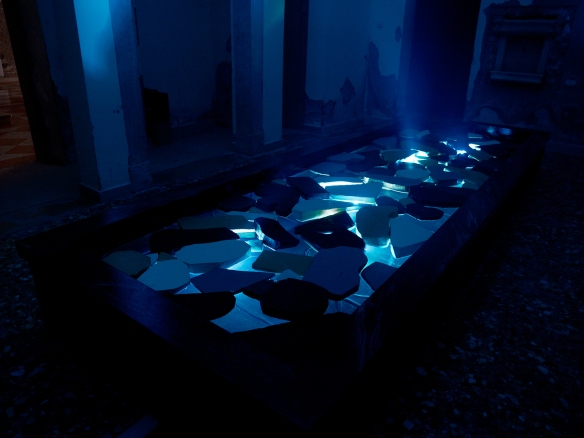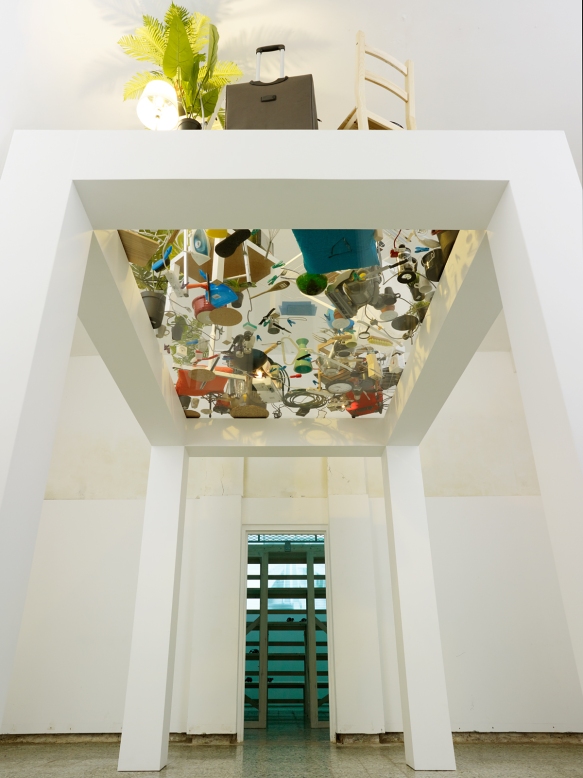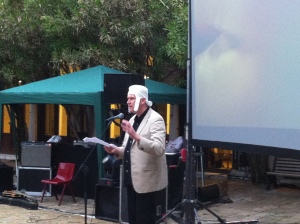Wales is back out in Venice for its sixth Venice Biennale and this time Bedwyr Williams has been selected to represent Wales at the Ludoteca in Castello. His solo show The Starry Messenger has just opened and is already stirring up a whole heap of media interest.
But what’s it like?
It’s like this: I am four or five years old, in the grip of a stomach bug that imprisons me in the tiny bathroom of my early childhood flat. There’s nothing to do but sit this one out and stare at the floor – old lino, printed to look like really bad terrazzo flooring. My eyes try to make sense of the odd shapes and blobs on the floor. The more I stare at them, the more the blobs seem to rise up to meet me and I experience a sinking feeling, like a pebble falling slowly into an abyss or an alternate universe. Gastro enteritis can do that to you. So can Bedwyr Williams and that memory floats to the surface of my mind as I get to grips with his obsession with terrazzo, linked to his love of amateur astronomy.
Let me walk you through The Starry Messenger.
Step off the dog shit festooned Venetian streets, out of the sun, or the sudden soaking shower that releases the smell of said shit and the perfume of the ubiquitous Tracheleospermum Jasminoides in equal measure. Inside the Ludoteca it is cool and dark. A mesh curtain printed to look like terrazzo is see-through enough to reveal what looks like a stargazer’s observatory beyond it. Through the curtain to peer at this large white erection (how did that get through the door then?) and there’s a sound of manly despair, endless looped sobbing. The door is ajar. The roof open, pointing at the heavens depicted on the ceiling and studded with tiny metal stars.
 Keep up now, we’re going into the next room to one of those ponds that feature in posh lifstyle magzines. Not an infinity pool but one that should be full of koi carp so expensive they make insurers nervous and owners take out contract killings on neighbouring cats. No fish in here though. Instead giant blocks of what look like granite but can’t be because they’re floating on the surface to a soundtrack of things breaking up or breaking down. It’s dark with blue lights to help make out the contours of these drifting chunks.
Keep up now, we’re going into the next room to one of those ponds that feature in posh lifstyle magzines. Not an infinity pool but one that should be full of koi carp so expensive they make insurers nervous and owners take out contract killings on neighbouring cats. No fish in here though. Instead giant blocks of what look like granite but can’t be because they’re floating on the surface to a soundtrack of things breaking up or breaking down. It’s dark with blue lights to help make out the contours of these drifting chunks.
 On down a dark corridor studded with tiny orange lights – like cosmic emergency lighting on a budget airline – and into a space where giant dark geometric forms loom all around and overhead, picked out by lights that pulse and change colour. We are small as molecules in terrazzo – if these are the quartz or granite chips then we are flecks of cement or sand.
On down a dark corridor studded with tiny orange lights – like cosmic emergency lighting on a budget airline – and into a space where giant dark geometric forms loom all around and overhead, picked out by lights that pulse and change colour. We are small as molecules in terrazzo – if these are the quartz or granite chips then we are flecks of cement or sand.
 So, feeling cut down to size, we stumble out into a brightly lit room, dominated by an immense glass-topped coffee table that we stare at from underneath. Its surface is strewn with seemingly randomly selected objects – if you tear up the Ikea and Argos catalogues and place anything that comes out as a whole image around the floor, this is sort of the effect, but there’s obviously a rationale between the choice of these objects that we’re peering up at, a cosmos of consumables with a white coat hanger gently swaying in the breeze of an office fan. If it weren’t for the steady flow of visitors we could lie on the floor and try and make sense of them.
So, feeling cut down to size, we stumble out into a brightly lit room, dominated by an immense glass-topped coffee table that we stare at from underneath. Its surface is strewn with seemingly randomly selected objects – if you tear up the Ikea and Argos catalogues and place anything that comes out as a whole image around the floor, this is sort of the effect, but there’s obviously a rationale between the choice of these objects that we’re peering up at, a cosmos of consumables with a white coat hanger gently swaying in the breeze of an office fan. If it weren’t for the steady flow of visitors we could lie on the floor and try and make sense of them.
 Onwards to the room where threads are woven together, but not necessarily into a garment you can immediately wear (think of those skirts that seem to have extra pouches, flaps and hanging straps). Sit with me on the bleachers, put on the radio headphones and here is Williams taking us on one of his surreal journeys. So we imagine we’re a chunk of something, probably a bit of rock and, to become part of the terrazzo, we’ll have to live with the idea of being ground down to a polished surface, the backs of our heads buffed away to a big wound (but don’t worry, Williams assures us it’ll scab over and we seem to be able to deal with this sacrifice).
Onwards to the room where threads are woven together, but not necessarily into a garment you can immediately wear (think of those skirts that seem to have extra pouches, flaps and hanging straps). Sit with me on the bleachers, put on the radio headphones and here is Williams taking us on one of his surreal journeys. So we imagine we’re a chunk of something, probably a bit of rock and, to become part of the terrazzo, we’ll have to live with the idea of being ground down to a polished surface, the backs of our heads buffed away to a big wound (but don’t worry, Williams assures us it’ll scab over and we seem to be able to deal with this sacrifice).
 Williams appears with a mosaic head, his outline instantly recognisable as his famous performance hat has been given the mosaic treatment too. (Dazed Digital gives you a two minute clip here so you get the idea)
Williams appears with a mosaic head, his outline instantly recognisable as his famous performance hat has been given the mosaic treatment too. (Dazed Digital gives you a two minute clip here so you get the idea)
For me to replicate the narrative would be ridiculous, it is convincing in the moment, but the imagery is fantastic and takes in everything from bondage to dentists.
Out of the dark and into the light again. Allow a few minutes for the ears to adjust to the chirruping sound that fills the little transitional courtyard. Are they crickets? Cicadas? Grasshoppers? Whatever they are one of them has just farted.
Exit through the broom cupboard, curated (for want of a better word) by Williams so that objects are arranged in a way that implies a relationship between things. Disturbing sounds of dentistry fill this claustrophobic space. I am happy to leave with my jaw aching.
Nearly done now. Out to the last part – a pile of neatly stacked little leaflets featuring a narrative that takes in perfume. I don’t know this as I pick one up, but my nose catches a whiff of expensive scent (Tom Ford I am reliably informed). The devil is in these details.
Behind the scenes of this show – one of the hot picks of the Biennale – is a vast team of curators (the show is co-curated by Oriel Davies and MOSTYN); technicians; fixers, committee members; administrators; invigilators; manufacturers, animators; art transporters; press and pr people with the Arts Council of Wales’ Louise Wright acting as Commissioner and Williams getting extra support from his gallery, Ceri Hand.This is no tuppeny ha’penny operation. The party is full of fancy folk, chatting over gin or Penderyn Whisky and the sausage rolls that made the Wales party famous years ago. Williams gives us another performance and we are moles again, as we were a few months ago when this project was launched in London and St Fagans. You’ll get the idea here.
You can also see more pictures of the show here courtesy of the BBC.
Or, if you can’t make it to Italy, wait for the show to tour Wales once the Venice Biennale shuts up shop again in November (if you don’t live in Wales, here’s a reason to visit).
I’m off to polish my head.





















